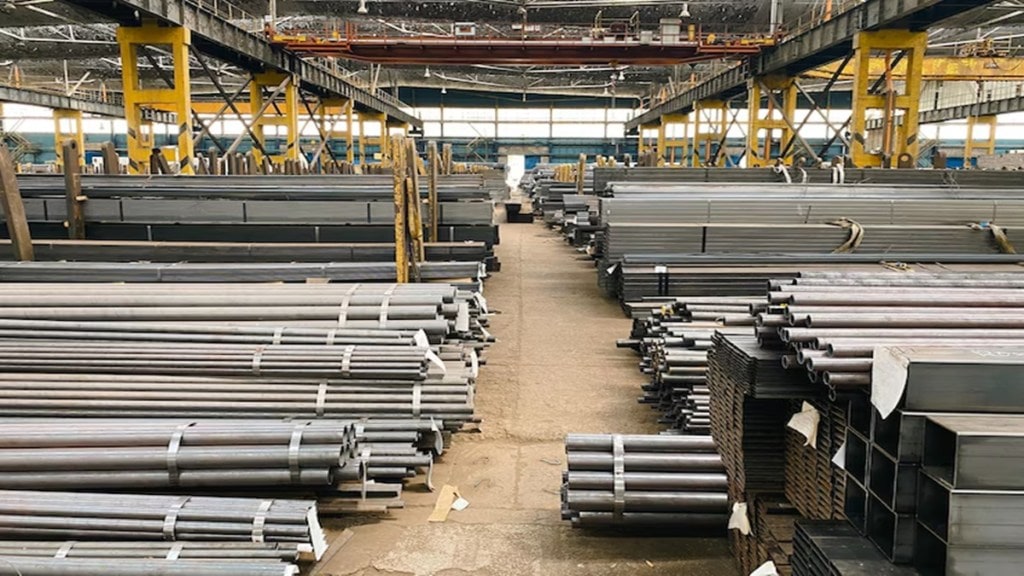The imposition of safeguard duty on steel imports in April has reined in inward shipments of the alloy rather suddenly, and enhanced the pricing powers of the domestic primary steel-makers.
However, this has the adverse fallout of raising the raw material costs of downstream players, and assorted industries that use steel as a vital production input. Since domestic inflation is currently subdued, the steel makers haven’t come under any great pressure as yet to bring down the prices.
The government imposed a 12% safeguard duty on steel products on April 1 for 200 days, primarily to rein in rising imports that increased 15% year-on-year to 9.5 million tonnes (MT) in FY25. An apprehension over a high influx of steel from China, Korea and elsewhere, following the imposition of a 25% import duty by the Trump administration, which took effect on March 10, may also have prompted the government to take the measure.
Subsequently, the Trump administration raised the import duty to 50% effective June 4. Although India didn’t tweak the rate with this in view, there has been industry representation to double the safeguard duty to 24%.
Meanwhile, India has notified the WTO of its intention to retaliate against the US steel tariff. Washington has raised the dubious argument that the duty was imposed for national security reasons to avert adverse ruling by the WTO.
Experts believe that Indian steelmakers should not be perturbed by the “prohibitive” US import duty, as the US accounts for only around 3% of India’s total exports. India’s total steel exports in FY25 stood at around 5 MT.
“US hiking import duty on steel should not be a headache for the Indian steel industry, as the US accounts for negligible Indian exports. However, since the prohibitive duty applies to all countries, except for a few, it might lead to undesired and predatory dumping into India, the country with the strongest demand for steel in the world,” said Dhruv Goel, founder and CEO at BigMint.
“India makes and sells most of its steel domestically, which partially insulates it from the U.S. tariffs.After China, India is the world s second-largest steel producer,with crude steel production of 150 million metric tons in 2024. A large portion of this output is consumed in the domestic market, given the infrastructure push by the public sector, and a booming construction sector.
Exports accounted for 6% of total steel production in 2024. Out of about 9 million tons of total exports, the U.S. share was only 3%. Hence, the direct impact of U.S. tariffs on the Indian steel sector remains negligible,” rating agency S&P said in a recent report.
The apprehension of rising imports has also been unfounded so far. In the first two months of the current fiscal, imports fell by 27% year-on-year to 0.9 MT, mainly due to a sharp drop in shipments from both China and Japan. While India doesn’t offer any favourable terms for the former, the latter has a free trade pact with India. However, India continued to remain a net steel importer as exports fell by 18% to 0.8 MT in the first two months of the current fiscal year.
Last fiscal, steel imports to India reached a decadal high of 9.5 MT, while exports crashed to a 10-year low of 5 MT. The recent trends, however, are encouraging for Indian steelmakers.
However, former SAIL chairman and chair-metals and mining at PHDCCI, Anil Kumar Chaudhary said, “Indian steel producers will continue to need protection from the dumping of cheap steel from China and other countries, where, of late, domestic steel consumption has been shrinking, with production levels remaining largely unchanged. If required, India may not hesitate to increase or even double the safeguard duty on steel. However, keeping in view the enhanced production capacity of steel at 205 MTPA, there is a strong need to increase the domestic consumption of steel further, to reduce dependence on exports and maintain the price line as well as profitability.”
India’s domestic consumption has not been an issue for quite some time now. Consumption growth at 11.5% was more than double the growth rate (5.3%) in the production of finished steel last fiscal.
“India’s economic growth rate is among the highest in Asia and the world. The country is investing heavily to meet rising demand and to address maxed-out capacity utilizations. Hence, it needs steel.
We expect domestic steel demand to expand by 8%-10% annually over the next three to five years. This is significantly higher than the global average growth rate of 2%-3%, rating agency S&P said in a recent report. The introduction of a safeguard duty has added an extra layer of protection for India's steelmakers,” S&P said.
The introduction of customs duty has also helped steel firms to raise prices. “We also think the duties cushion prices and margins, and may have weakened the correlation between global steel prices and India. For example, Chinese steel prices have fallen 5% since the U.S. first announced steel tariff hikes on Feb. 10, 2025. Over the same period, domestic steel prices in India have gone up by 7.6%,” S&P said.

